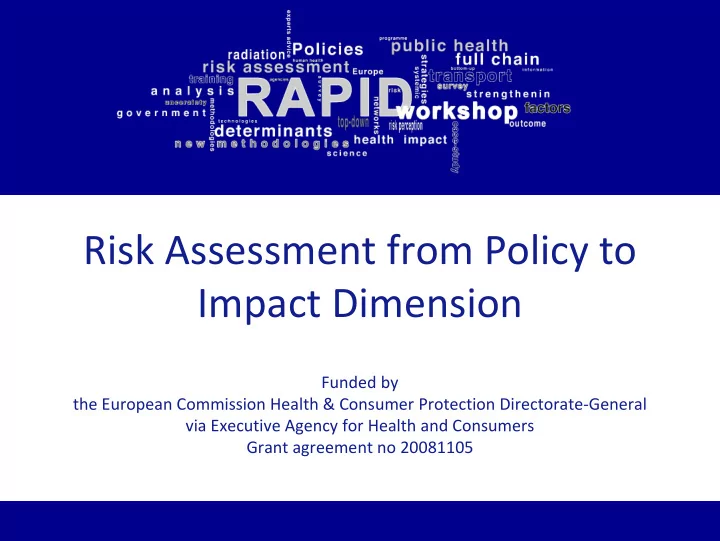

Risk Assessment from Policy to Impact Dimension Funded by the European Commission Health & Consumer Protection Directorate ‐ General via Executive Agency for Health and Consumers Grant agreement no 20081105
Coordinated by SDU ‐ University of Southern Denmark, Unit for health promotion research, Esbjerg, Denmark www.sdu.dk/healthpromotion Partner organisations: • IVZ RS ‐ Institute of Public Health, Ljubljana, Republic of Slovenia, www.ivz.si • LIGA.NRW ‐ Landesinstitut für Gesundheit und Arbeit des Landes Nordrhein ‐ Westfalen, Düsseldorf, Germany , www.liga.nrw.de • UD MHSC Faculty of Public Health University of Debrecen, Hungary www.sph.dote.hu • IFC ‐ CNR ‐ National Research Council, Institute of Clinical Physiology, Pisa, Italy www.ifc.cnr.it • EASP ‐ Escuela Andaluza de Salud, Granada, Spain www.easp.es • SMLPC – Health education and disease prevention centre, Vilnius, Lithuania www.smlpc.lt • MUS ‐ Department of Public Health, Medical University of Silesia, Katowice, Poland www.sum.edu.pl • TU ‐ Trnava University, Faculty of Health Care and Social Work, Trnava, Slovak republic www.truni.sk • RUVZ ‐ Regionalny urad verejneho zdravotnictva, Kosice, Slovak Republic www.ruvzke.sk • UBB ‐ Babes ‐ Bolyai University, Clij ‐ Napoca, Romania www.ubbcluj.ro • WHO European Centre for Environment and health, Rome, Italy www.euro.who.int/ecehrome 2
Background • Policies and strategies influence the wider determinants of health. These determinants have their impact on a range of different risk factors which then directly affect human health. • RAPID grew ‐ out from a previous project “Health impact assessment in new member states and accession countries” (HIA NMAC). HIA NMAC identified a lack of risk assessment methods for conducting policy health impact assessments across areas of broad determinants of health. 3
General objectives • The main objective of RAPID project is to develop methodologies for conducting "full chain" risk assessment (policy ‐ determinants of health ‐ risk factors ‐ health effect) , and implement them on case studies and on a selected EC policy. 4
Full chain methodology •Liver Cirrhosis •Risk assessment, perception, communication, management • → ↕ ← •Different population •Alcohol consumption •Risk assessment, perception, communication, management • → ↕ ← •Different determinants •Social determinants •Risk assessment, perception, communication, management • → ↕ ← • Different sectors and policies •Policy 5
Model methodologies for bottom ‐ up risk assessment in a range of themes • Osteoporosis, SDU, Denmark • Prevention of deaths and injuries related to traffic accidents EASP, Spain • Chronic liver disease and cirrhosis, UD MHSC, Hungary • Road traffic injuries, LIGA.NRW, Germany • Primary healthcare sector, MUS, Poland • Liver cirrhosis, RUVZ, Slovak Republic • Asthma, TU, Slovak Republic • Chronic obstructive pulmonary disease, IVZ RS, Slovenia 6
Model methodologies for top ‐ down risk assessment in a range of themes • Tobacco policy, UD MHSC, Hungary • Energy policy of Denmark, SDU, Denmark • Housing subsidy program, LIGA.NRW, Germany • Air pollution legislation, MUS, Poland • National alcohol problem plan, RUVZ, Slovak Republic • Road safety and injuries, TU, Slovak Republic • Wine production, IVZ RS, Slovenia • Computer tomography for cancer risk, IFC ‐ CNR, Italy • Road traffic safety policy, VASC, Lithuania • National pandemic influenza plan, UBB, Romania 7
A policy assessment case study developed on a EU policy • EU Health strategy – work in progress 8
Full chain methodology • Top ‐ down – relevant for impact assessment and starts by a policy • Bottom ‐ up – relevant for putting health on agenda and start by a relevant health issue 9
Top ‐ down methodology • Policy – Identify the problem, policy analysis, context, target population, time course… • Determinants of health – Model, identify major determinants influenced, strength of evidence, causality, severity of impact, interactions among determinants, … • Risk factors – Identify those influenced by determinants, qualitative/quantitative assessment, strength of association, evidence, causality, loops among risk factors and determinants, population, … • Health outcome – ICD codes, direction of change 10
Bottom ‐ up methodology • Health outcome – ICD codes, relevance, population… • Risk factors – Identify those influencing the health outcome, qualitative/quantitative assessment, strength of association, evidence, causality,, … • Determinants of health – Model, identify major determinants influencing the risk factors, strength of evidence, causality, severity of impact, interactions among determinants, loops among risk factors and determinants, … • Policy – Identify policies, policy analysis, context, target population, time course… 11
National workshops • Discuss the assessment checklist (tool, method, guidance) • Provide feedback 12
Recommend
More recommend